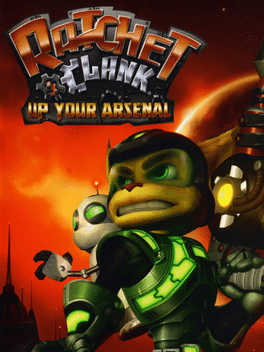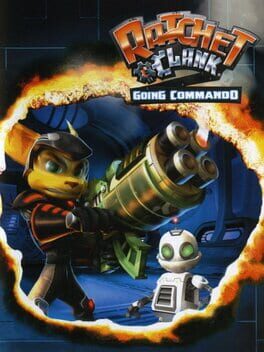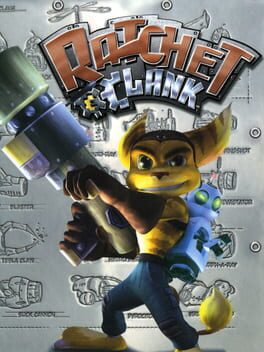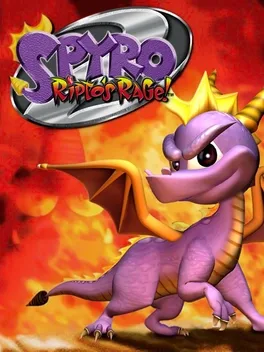(Originally published to Glitchwave on 1/25/2025)
[Image from glitchwave.com]
Ratchet: Deadlocked
Developer: Insomniac
Publisher: SCE
Genre(s): Third-Person Shooter, 3D Platformer
Platforms: PS2
Release Date: October 25, 2005
The premise of Deadlocked sees a familiar trope of the series only seen as a subsidiary lark blossoming to the center stage. In both Going Commando and Up Your Arsenal, Ratchet would engage with the challenges of a gladiator-esque combat arena conducted under the guise of a televised program–satirically jabbing at our then-prevalent fascination to watch people in grievous pain on television. Seeing Ratchet dominate the airtime of both Galactic Gladiators and Annihilation Nation was certainly commendatory, but both of those game shows were bush league compared to Deadlocked’s “DreadZone.” While Dreadzone is an intergalactic sensation, they evidently don’t receive too many applicants eager to star on their show. Ratchet learns this the hard way when goons infiltrate the Starship Phoenix and abduct him along with Clank and Al and take them to the grounds of Dreadzone’s space station. Ratchet and friends have been forcefully contracted to compete in Dreadzone’s tournament of champions against their will as “Team Darkstar.” It’s a collaborative effort between all three, but Ratchet is the field man undergoing Dreadzone’s death-defying stunts in the name of entertainment. If they refuse to comply by removing the monitoring collars wrapped around their necks, their termination from the show will carry literal consequences, if you catch my drift. While Clank and Al begin working on deactivating their constricting neck vices, Ratchet must perform to the best of his ability and not succumb to stage fright–ensuring their survival in this sordid state of affairs. If a Ratchet & Clank game was going to verge closer to the spectrum of shooting combat, then expanding the gladiatorial arena aspect of the series to the expanse of a fully-fledged title is a perfect segway into this direction while being faithful to the series’ conceptual properties. All the while, the narrative is elevating the stakes of the premise to something genuinely filled with tension.
Even though Dreadzone televises a good portion of their episodes in a stadium located on their network’s space station, Deadlocked would be quite dull if every waking moment of the game took place in this confined building. Dreadzone is ostensibly such a phenomenon across the galaxy that their budget allows them to acquire filming permits for several different planets. Hell, the courses on each planet suggest that the production values for Dreadzone are extravagant, zoning entire countries of land for the development of their dangerous obstacle courses. While being an indentured contestant on Dreadzone still allows Ratchet to be the interplanetary traveller he’s always been, the locales don’t exactly feel as sprawling and organic as they did across each game of the original trilogy. Think of the linear, mission-based ranger missions from Up Your Arsenal and that’s the construct of Deadlocked’s gameplay in a nutshell. There is an overarching task for each planet divided into four or five objectives that will incrementally complete the primary goal. For the most part, each mission boils down to Ratchet blowing his way past point A to B with a few progression impediments that require Ratchet to make a slight deviation on his trek like screwing in a bolt with his wrench or deactivating a forcefield. Even when these impediments pop up, they’re intended to be dealt with by Ratchet’s new twin battlebot helpers who act as a surrogate for Clank. Having servants do the menial aspects of fieldwork is nice and all, but expediting the objective by enlisting their help makes the already impactless mission seem more trivial. When the mission bears some heftier narrative context like reactivating a forcefield for a planet that’s bound to be bodied by a storm of meteors without it, it’s not enough to distract the player from realizing that it’s the same old song and dance as every other mission in the game. Vehicles are incorporated into at least one task per planet, but they tend to wear out their welcome as quickly as the missions performed on foot. Not even the reinclusion of grind rails adds a hint of spice to these stale, bland levels. The only moments in Deadlocked that maintain a certain thrill due to their restrained presences are the exterminator duels, Dreadzone’s brick walls intended to smite contestants when they surpass their expected airtime that serve as Deadlocked bosses. Ranger missions in Up Your Arsenal were an adequate change-up from the standard Ratchet & Clank levels in moderation, and the same can be said for the cavalcade of challenge courses that Annihilation Nation offered. However, a game composed entirely of their simple, linear tasks will severely underwhelm the player and grate on their attention spans.
Naturally, Dreadzone is inclined to make their television product more interesting by unleashing their throngs of murderous machines into the fray. Dreadzone’s attempts to pulverize Ratchet with their malicious mechanized contraptions is what facilitates the series’ shooting gameplay, scattering the areas with the staticky nuts and bolts of the fallen enemies in Ratchet’s wake. Above all else, the Ratchet & Clank series is best known for its roulette of eclectic and creative weaponry, and each title in the original trilogy refreshed Ratchet’s arsenal for each subsequent entry to keep the player salivating at what kooky firearms the developers would devise. In Deadlocked, the weapon count has been reduced to about only a dozen, and they’re easily the least creative batch in the series thus far. At this point after three titles, the weapons of Ratchet and Clank have been cemented into archetypes, or at least it seems that way from what Deadlocked displays. The Magma Cannon is the same shockwave shotgun as the Blitz Cannon was back in Going Commando, The Arbiter is the latest incarnation in a long line of powerful missile launchers, and it's no coincidence that the Fusion Rifle can be used as a juggernaut weapon at close range just like the Flux Rifle despite its intended functionality. I’m convinced Ratchet conveniently had the Mini Turret Launcher tucked away in his pocket from the previous game. In the midst of all of these derivative copycats is the Scorpion Flail, the one exemplary pick from Deadlocked that kicks like a mule and is a more functional evolution of the supercharged melee alternative weapon that the Plasma Whip introduced. Alas, caving in the heads of enemies with the cybernetic medieval device is not enough to carry the weight of its half-assed contemporaries. One slight point of variation with the weapons that Deadlocked does implement is streamlining the elemental modifications that are purchasable from any vendor. The ability to equip any mod to any gun (even if it’s nonsensical like a bomb launcher that turns enemies into farm animals) is a true quality-of-life enhancement that can add a bit of flavor to the weapons if deemed necessary. Still, the ability to pick and choose whether to deprive a weapon of its maximum amount of ammunition and rate of firing acceleration seems silly to me.
While Deadlocked’s gameplay attributes are generally uninspired, the narrative is conversely pulling all the punches of another piece of Ratchet & Clank social commentary. One of the more understated elements of the Ratchet & Clank series is its penchant for subtly sprinkling biting comments on modern society at large through the lens of a lighthearted, cartoonish video game set in a future possibly several millennia away. Usually, Insomniac finds it imperative to critique capitalism and society’s fascination with celebrity culture. Deadlocked expresses the most overt commentary on these particular subjects, but this does not mean that the game doesn’t deliver something poignant. The series has already prodded at the exploitative nature of reality television, but Deadlocked dives deeper into the subject of who is profiting off the exploitation of others. Like Chairman Drek before him, Vox Network CEO Gleeman Vox has no scruples in how he rakes in the gonzo bucks. I’d compare his unmitigated avarice to a shark, but the developers already beat me to the punch by externalizing him as such. The form of a creature associated with cold and bloodthirsty character traits is quite fitting for Vox, for every bit of carnage he enables through his hit gameshow makes him salivate at the prospect of viewership boosting the ratings and how much commercial time he can put in to potentially make more millions selling his products. Death and destruction are what he craves to bolster his eminence as a media mogul, making him the most despicable Ratchet & Clank antagonist even without the developers giving him a Napoleon complex and a ponytail to do so. On the celebrity side of the satire coin, Vox’s favorite tool to use in his mission to fill an Olympic swimming pool with blood money is Ace Hardlight, the de facto star of Dreadzone due to his esteemed rank as the show’s top exterminator. I use the term “tool” almost literally, as Ace has no agency in his career thanks to Vox dictating his every action to keep him presentable to the public. Ace compromises the code he used to abide by as a hero, turning him into a megalomaniac as detestable as his corporate puppet master. Despite his name, status, and persona, the game effectively depicts Ace as pathetically as possible. He’s emblematic of the truth that any dashing big screen icon that people admire and or envy for their lavish lifestyle often has an ugly force of evil pulling their strings.
Unfortunately, the satirical story of Deadlocked is only substantial in a vacuum. Some Ratchet & Clank fans often express disappointment that Clank’s role has been reduced to a fly-on-the-wall tutorial like Bently was in the first Sly Cooper game. To compound on this gripe, I’d argue that the same impersonal regression applies to Ratchet. Sure, he’s still center stage as the protagonist, but it always seems as if he’s a secondary component to the narrative and it’s all happening around him instead of him driving it. The gladiator helmet that obscures his face isn’t only to protect Ratchet from bodily harm or possibly provide oxygen–it’s a muzzle that muffles his personhood. Outside of speaking to Clank and Al in between rounds, Ratchet doesn’t interact much with the Dreadzone-centric characters until he confronts both Ace and Vox near the end. By then, we almost forget that he has any relevance to the other characters. The conspicuous characters in Deadlocked’s story seem to be the corny and irritating commentators of Dallas and Juanita, plus Vox on the sidelines. Every moment on the field seems to be dedicated to their inane chatter, and most of the cutscenes involve them recapping Ratchet climbing up the Dreadzone ranks. They’re effective characters for the greater scope of the statement the game is trying to make, but their greater presence in the narrative over the titular character makes me wonder if Deadlocked could have existed as its original IP rather than branching off of an established one. It’s not as if Ratchet & Clank have a trademarked stranglehold on futuristic, animated shooter games with tidbits of satire abound. Because Deadlocked diverts the focus off the chemistry between the unlikely duo we all know and love, Deadlocked loses the classic Ratchet & Clank charm.
Replaying Ratchet: Deadlocked has affirmed the lukewarm feelings I’ve always felt towards it. However, re-evaluating this bite-sized serving of Ratchet & Clank content has made me question why I’ve always held Up Your Arsenal in high esteem. Does my exhaustion regarding Deadlocked’s shooting combat expose the faults of Up Your Arsenal’s concentration on this aspect of gameplay? While the combat in Deadlocked shares a stark similarity with Up Your Arsenal’s, the last entry in the PS2 trilogy was not solely a string of tests that proved the player’s shooting moxie. Up Your Arsenal still shared the plucky, yet epic adventure atmosphere of the two previous games despite it making a discerning effort to inflate the shooting aspects. Deadlocked, on the other hand, is essentially one long checklist of straightforward tasks that involve shooting, and the story isn’t so riveting that it prevents the tedium of playing through it to set in quickly. Speaking of Deadlocked’s story, it lacks a certain charisma that comes with the notable characters, choosing instead to have the game revolve around new faces that pronounce the satirical equation of the series more overtly than usual. Deadlocked verges too harshly in a narrower direction than anything the original trilogy presented, congesting itself with too much of one thing and making the player sick as a result. If Deadlocked is an isolated experiment to see where the combat threshold of the series is crossed, I’d say it stepped over the border about three planets in.




